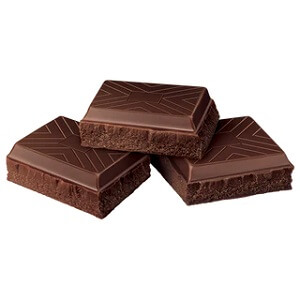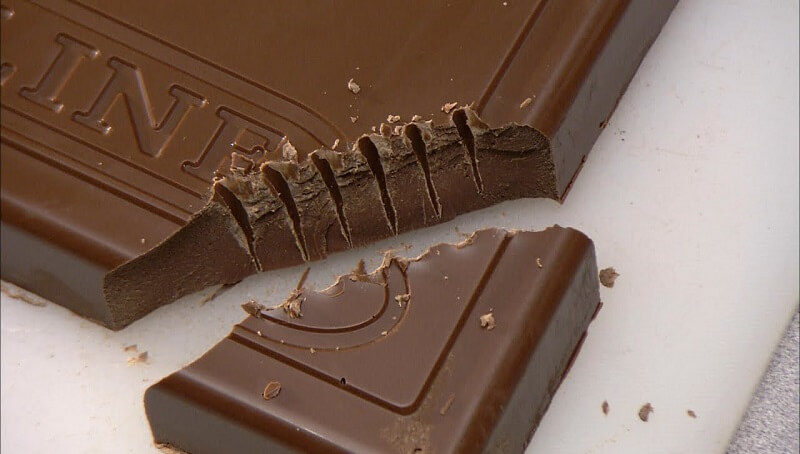I’m sure it is as frustrating for you as it is for me to try a recipe you know nothing about and not understand the quantities of the ingredients and how much of each you will need from the store. Take chocolate for example: In some recipes, you will find a whole description of what you need, so 1/2 pound block of bulk chocolate for example, while in others you will only get the weight, like 5 ounces, or a certain quantity in volume, like 1 cup, for example.
But what do all of the numbers actually mean? And more importantly, how much chocolate do you actually have in a pound? As we’ve done in the past, we went through a bunch of experiments to make you understand how much chocolate you’ll need to buy and make cooking just a pinch easier.
As you know, chocolate is usually sold in blocks on a per-pound basis, so to make everything a little easier, we have picked a block of chocolate weighing 1/4 pounds for our tests.
You will usually get anywhere between 2/3 and 3/4 f a cup of chocolate when you break the 1/4 pounds block of chocolate into chipped pieces. It, of course, depends on the actual size of the chocolate bits you’re getting. This translates into a full pound of chopped chocolate fitting into about 2.7 to 3 cups. These cups full of small chips weigh about 167 grams or around 5.8 ounces.
You might also like our articles on the weight of blackberries, blueberries, and eggs.
When melted, the 1/4 pound of bulk chocolate will occupy around 1/2 of a cup. If you buy a full pound of chocolate, then it will clearly fit inside two cups after melting. On the other hand, if you were to grate a 1/4 pound of chocolate, you will get about 1 cup. This means that 1 ounce will get you about 1/4 cup of grated chocolate. The best tools for grating chocolate are either a box grater on its smallest hole side, a handheld grater, or a microplane grater. If you want some fancy-looking chocolate curls, then use either a vegetable peeler or a simple cheese slicer.
When shopping for chocolate, you will notice that many grocery stores have different chocolate types, like white, semi-sweet, milk, and so on, but also different brands, shapes, and sizes. When it comes to chocolate chips, they are usually used when baking and will contain considerably less cocoa butter than other types of chocolate.
 One of their best features is the fact that they retain their texture and shape, making them great for baked desserts and cookies because they will resist moderate heat in the oven. This is why determining the normal weight isn’t really all that simple. For example, a cup of Nestle or Hershey’s regular-size chocolate chips will have a weight of about 6 ounces.
One of their best features is the fact that they retain their texture and shape, making them great for baked desserts and cookies because they will resist moderate heat in the oven. This is why determining the normal weight isn’t really all that simple. For example, a cup of Nestle or Hershey’s regular-size chocolate chips will have a weight of about 6 ounces.
Here’s a nice little piece of information: Each pound of chocolate, which translates to about 450 grams, is made from around 400 cacao beans. You can easily store dark chocolate for up to five years and this is mostly because of the natural preservatives contained in it. On the other hand, both white chocolate and milk chocolate should be used within a year, and this is because they have milk solids in their list of ingredients, making them spoil easier.
Another interesting fact is that although it is called chocolate, white chocolate isn’t considered chocolate, because it doesn’t have cocoa liquor or cocoa solids in its recipe. It does have some content of cocoa butter from cocoa beans, though.
The information above should make it easier for you to understand how much chocolate is in a 1/4 block, regardless of whether you need it chipped, grated, or melted. If the information above is not enough, then you can always use the tool we provide below and get numbers for any measurements you’re interested in. If you’re thinking of using a lot of chocolate in your recipes, it might be a great idea to buy a microplane or box grater. When grating chocolate, you can get some amazing results by using the box grater on the side with the smallest holes.
Side Notes on Chocolate
Make sure you know exactly what type of chocolate you need for your recipe, because there are actually many different types out there, including unsweetened cocoa powder, candy coating, which is basically a cheaper candy product, gianduja – a European style, couverture – used by professionals which also makes it expensive, white, milk, dark, semi-sweet, bittersweet, dark, or unsweetened.
How to Store a 1/4 Pound Chocolate Block
General Info on How to Store Chocolate
Keep in mind that substituting chocolate types in recipes might change the final result. Each chocolate type will have its own added sugar and cocoa butter amounts.
Even though cocoa butter might come to the surface and separate from the other ingredients, getting a crystalized consistency when you store chocolate at a higher temperature, you should know that although the chocolate will look a lot different, it can still be used.
Short-Term Chocolate Storage
Chocolate is best stored in a place that is dark, dry, and cool. Any place with less than 50% humidity and a general temperature between 15.6° to 21.1°C (60° to 70°F) would be perfect. You should either put the chocolate in an airtight container or just keep it in its original wrapper. Dark chocolate can easily keep for a few years, while white and milk chocolate shouldn’t be kept for more than 8 to10 months. Semisweet and bittersweet chocolate can also be kept for several years, and this is because neither of them contains any milk solids.
Long-Term Storage for Chocolate
If you want to freeze chocolate for later use, then just leave it in its wrapper or put it in an airtight container and leave it there until it reaches room temperature. You do this as a way of preventing condensation from forming on the chocolate.
